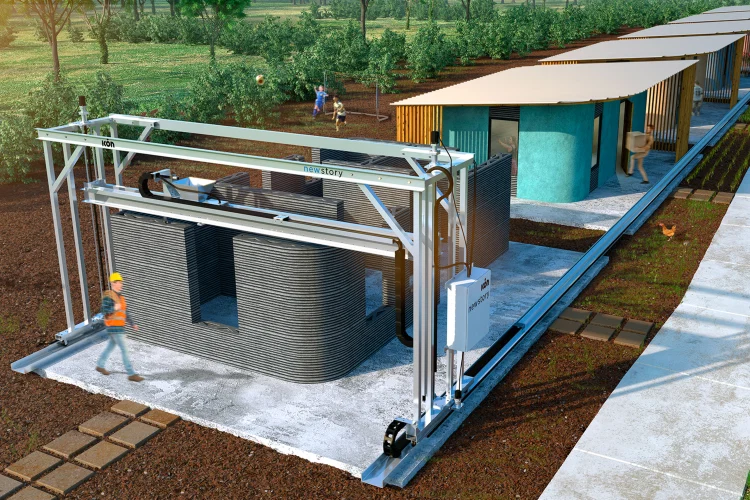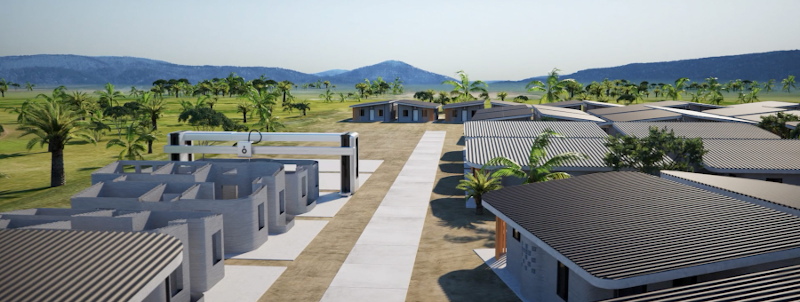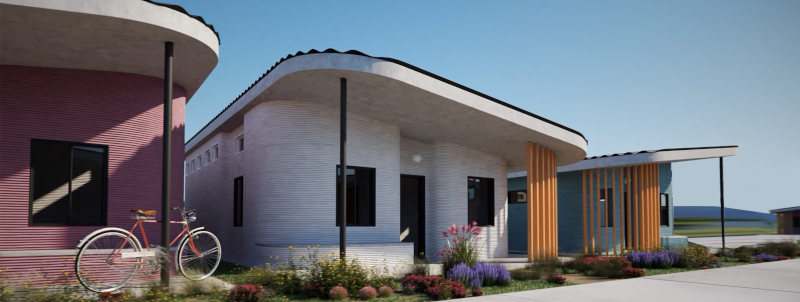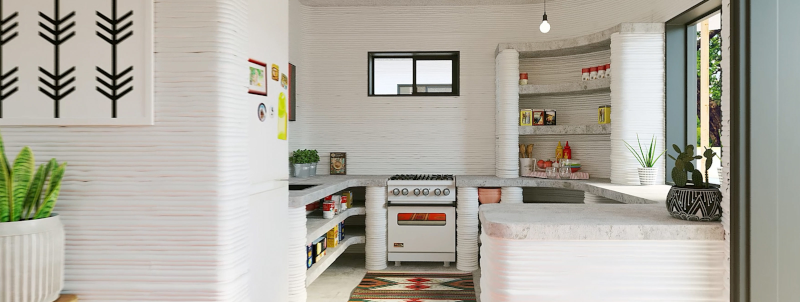
Charles Goulding and Andressa Bonafe consider a new year of advanced manufacturing-driven construction solutions.
At the start of a new year, we thought it would be a good idea to look for inspiration in innovative ways to apply 3D printing technology for the benefit of those in need. This is exactly what New Story Charity, ICON, and fuseproject are doing. Based in San Francisco, California, New Story is a nonprofit organization that pioneers solutions to end global homelessness. With 3 billion people expected to be living without access to adequate shelter by 2050, there is an urgent need for strategies to build faster, better, and stronger homes.
3D Printing Impactful Homes
New Story’s three pillars of action are great guidelines for those willing to implement purposeful, high-impact innovation in 2021:
- Create: develop new methods and breakthrough solutions
- Prove: implement new tools and technology while listening closely to all the agents involved, particularly those that should benefit from each initiative
- Share: understand that global problems must be tackled with an inclusive approach. This is the basis for sharing helpful solutions with other organizations and governmental institutions.
Aware that traditional homebuilding techniques will not be able to meet the growing need for shelter, New Story has partnered with construction technology company ICON to explore alternative solutions. This collaboration resulted in the development of Vulcan, a 3D printer capable of printing the structure of a safe and affordable home.
Unveiled in 2018, ICON’s Vulcan (and the Vulcan II in 2019) has allowed for the creation of the world’s first 3D printed community in Tabasco, Mexico. The 3D printer utilizes a proprietary concrete mixture called Lavacrete, which is made of local materials and produces zero waste. Its wall system takes the place of traditional cladding, framing, and sheetrock—delivering a higher-quality wall at significantly lower costs.
By combining adaptable design and Vulcan’s groundbreaking 3D printing technology, the New Story project aims to provide families in Latin America with affordable housing that adapts to their day-to-day lives. Targeting a population made up mostly of farmers and artisans who live in multi-generational environments, the initiative builds upon the input from the community to ensure that their particular housing needs are met.

Throughout the project, 3D printing technology has been central in addressing important questions related to climate, household structure, and the role that the homes play in creating community. Examples include the need to build flexible structures that allow for the construction of second floors as families grow. Environmental and seismic activity is accounted for through additional reinforcement into the wall cavities as well as overhang roofs that create shade from the sun and protection from rainfall.

Additive manufacturing was also utilized in the creation of built-in elements such as counters in the kitchen and bathroom, seating, shelves, and ledges in the walls, and embedded structural hooks for building closets, storage, and clothes-lines. Customization options are available to help families personalize their homes and foster a sense of ownership.

Winner of the Fast Company Innovation by Design 2020 (Cities Category), New Story’s effort underlines the undeniable potential of additive manufacturing as a powerful, scalable, and affordable tool to meet the needs of underserved populations. Phase one of the project will serve about 200 people in 50 homes. In the long term, the community will have closer to 400 homes total, impacting thousands of people and paving the way for broader implementation across Latin America and beyond.
While changing the lives of underprivileged communities, 3D printing also promises to revolutionize for-profit homebuilding. Building companies that take advantage of innovation in additive manufacturing are likely eligible for Federal and state tax incentives, such as Research and Development (R&D) tax credits.
The Research & Development Tax Credit
Whether it’s used for creating and testing prototypes or for final production, 3D printing is a great indicator that R&D Credit eligible activities are taking place. Companies implementing this technology at any point should consider taking advantage of R&D Tax Credits.
Enacted in 1981, the now permanent Federal Research and Development Tax Credit allows a credit that typically ranges from 4%-7% of eligible spending for new and improved products and processes. Qualified research must meet the following four criteria:
- Must be technological in nature;
- Must be a component of the taxpayer’s business;
- Must represent R&D in the experimental sense and generally includes all such costs related to the development or improvement of a product or process;
- Must eliminate uncertainty through a process of experimentation that considers one or more alternatives.
Eligible costs include US employee wages, cost of supplies consumed in the R&D process, cost of pre-production testing, US contract research expenses, and certain costs associated with developing a patent.
On December 18, 2015, President Obama signed the PATH Act, making the R&D Tax Credit permanent. Since 2016, the R&D credit has been used to offset Alternative Minimum Tax (AMT) for companies with revenue below $50MM and, startup businesses can obtain up to $250,000 per year in payroll tax cash rebates.
Conclusion
The first 3D printed community in Tabasco, Mexico illustrates the revolutionary power of 3D printing to fuel high-impact, purposeful innovation. In the for-profit sector, efforts to build faster, better, and stronger homes are likely eligible for R&D tax credits.
